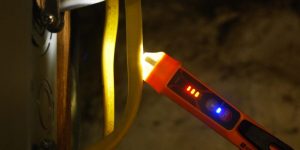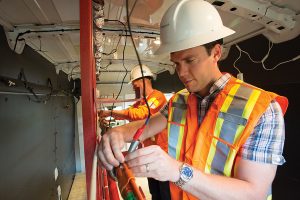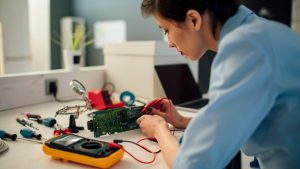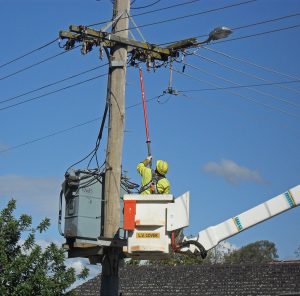Home » Posts tagged 'hot stick testing'
Tag Archives: hot stick testing
What is Hot Stick Testing and Why is it so Important?
What is a hot stick?
An active electric power supply is very hazardous. Line crew should be kept safe when performing service tasks during hot stick testing. This line personnel works in energized high-voltage power lines. A risky mission, therefore, they require the best protection. Mostly, the line power status is always unknown. They need to be protected from electric shock by performing hot stick testing. Its central importance is the welfare of the technicians.
A hot stick is a tool that provides safety to the line crew. The testing process is used to determine a live wire status before the workers indulge in their tasks. It’s a high quality, fiberglass and foam-filled long pole that maximizes mechanical and insulation strength.
Line crews for cable companies require this testing process in their line of work. The fiberglass is the key feature that provides an excellent insulator. It doesn’t conduct electric currents down the device.
Types of a hot stick.
There are two types of devices for hot stick testing:
• Telescoping
• Shotgun.
Telescoping.
Telescopic testing is perfectly designed for speed, long reach, safety, and convenience. This hot stick is made of hollow sections. These sections are covered with fiberglass for high dielectric and greater strength that meet OSHA (Occupational Safety and Health Administration) standards. Its retractable ability makes it an ideal tool that can be in any compact space.
Shotgun.
This hot stick is made of a sliding lever mechanism. During hot stick testing, helps a technician to open and close the hot shotgun stick. For this reason, the user easily attaches it to a detachable ring and closes it. This type of hot stick got its name from the pump-action shotgun. They both look almost the same.
WHEN AND HOW TO USE A HOT STICK.
Hot stick testing helps isolate and insulate the technician from the blast, electric shock, or arc. Typical procedures that will require this testing procedure:
· Voltage measurement
· Any modifications or repairs to energized equipment
· An operation of cutouts and disconnects
· An application of safety grounds
The hot sticks testing depends on the task to be performed and the location of the technician. Generally, any time the hot stick procedure is happening, the line crew should put on protective clothing. Besides a face shield and rubber gloves, flash suits are the most recommendable. However, before the process, a thorough inspection should be conducted to ensure no physical damage is observed. That has a significant impact on the insulating ability, thus posing a threat. In case of permanent damage like a split or a crack, it is advisable to replace it.
What is hot stick testing?
According to OSHA, all fiberglass-reinforced products (FRP) should be electrically every two years. The only reason that can stop the process is when the device has not been repaired. The technician should ensure the tool has no defects since during hot stick testing, they pick contaminants, making them less safe and more conductive.
A tool should have a contaminated surface or internal conductivity during the testing process to fail the dry test. There has never been a hot stick testing that ever failed this dry test, even using hot rods that were chosen due to surface abuse or heavy scarring. On the other hand, heavily scarred sticks can fail the wet tests, despite cleaning and even applying silicone oil or wax.
In case a hot stick surface wet-out after water is applied, it shows that the device requires maintenance. Silicone or waxing may help in case the stick is still in excellent condition.
During the wet hot stick process, applying too much water causes a false failure due to water collecting along the stick’s bottom. However:
• The testing is recommended after every 24 months.
• FRP tools will require a wet hot stick testing for a minute at 75,000 Volts per foot. The process verifies the device’s integrity and its whole working length.
• An alternative Watts-loss, performed at a very low voltage, is also an acceptable hot stick testing method.
• Never perform a wet hot stick process on wood devices. This is so wood tools are advised to stay far away from water.
To optimize the effectiveness and safety when dealing with high-voltage electric lines, technicians must understand how to do hot stick testing keenly.
Here are the most beneficial ways of hot stick testing techniques to inspect before working with activated lines:
Hot stick calibration.
Hot sticks testing calibration and maintenance ensure that they are efficient. According to OSHA standards, hot stick testing and inspection should be done periodically. Frequent inspection and calibration guarantee reliability and accuracy of the hot.
Testing and Maintenance.
• Daily scheduled and checks routine inspections.
It would be best if you inspected and tested your hot stick before and after use. Checks are done if the surfaces have any cracks, scratches, dents, burn marks, excessive wear, blistering or electrical tracking. In addition to that, the process regularly ensures the volts are at the required level.
• Regular Cleaning.
Cleaning protects the device from surface contamination to keep the technician safer from electric shock. Use disposable silicone wipes to clean and remove moisture on the surface for the hot stick procedure. It should be done before and after using the stick.
• Wax your hot stick after cleaning.
Using fiberglass wax, apply only two after every clean to retain its finish. It will maintain a glossy feel and protect your device. This is important to the safety of the technician and the use during the process.
• Handle with care.
Ensure the device is not contaminated. Handle the hot stick carefully from getting in contact with dirt; it can cause defects.
• Store your hot stick correctly.
Protective bags and tubes are readily available to store your hot stick tool in a secure and safe place, even when transporting them. Store in storage racks to keep them in excellent condition.
Hot stick cleaning.
Every hot stick device should be clean before and after use daily. They should be visually inspected and wiped properly before any task is undertaken. Any contamination or defect will adversely impact the mechanical integrity or insulation qualities of the hot stick testing. After every service, inspect and clean your device as prescribed by OSHA.
According to OSHA, every live-line device will be visually inspected and wiped clean for any defects before and after use each day. Technicians’ safety comes first; hence hot stick procedure is imperative. Keep it tidy to ensure the surface has no contaminants. The contamination may be brought by:
• Conductors and carbon tracking
• Wind, rain, snow, and other weather states
• Storage grease or daily dirt and greases from
For hot stick cleaning, a silicone wiping cloth is used to wipe the device after the process. This adheres to OSHA rule since the tools are not cleaned in any case; they shall be at service. The silicone film on the sticky surface will repel contamination and water to ensure dielectric properties are maintained. It will be safe enough during adverse and wet conditions.
On the other hand, if the contaminants are more challenging to get rid of, using a hot stick cleaner can be the solution. But if it still doesn’t clean the surface well, an all-purpose cleaner is recommended.

Refinishing.
The extended hot stick procedure period leads to scratches, nicks, scrapes, and exposure to other elements. Here, wiping out the surfaces might not improve the appearance of the device. However, it does not mean it should be discarded unless it’s mechanically faulty.
This is whereby the use of a refinishing kit comes in. The equipment helps restore it to a new condition. A refinishing kit takes at least 24 hours of drying time. It is an excellent opportunity to refinish your hot stick testing tool with downtime during the rainy season. At the same time, refinishing your hot stick device, it is advisable to disassemble them.
Disconnect tools, heads, and other parts. After which you use a sand-paper to get rid of old finish and surface scratches. Then you clean and wipe dry the hot stick tool to rid any contaminants or dust with an item of lint-free clothing. Spray the stick with a cleaning solvent to remove any residue.
The refinishing kit will only work well with fiberglass hot stick devices. Once you have done the refinishing process, apply two coats of wax to your hot stick equipment to slow down contaminants’ formation. It becomes more comfortable to maintain and clean—the lifespan of the fiberglass increases.
Hot stick visual inspection.
It is necessary to keep hot stick procedural tools safely to avoid disasters like cracks and chips. Most technicians have been trained to inspect their hot stick devices before they get to work keenly. They keep track of the tools’ condition and check on any visible damages.
• Hot sticks must be cleaned and visually inspected daily before and after use.
• Store the hot stick tools away from ozone, sunlight, or chemical or substance that threaten the device.
• The hot stick devices must be transported in special storage tubes or bags.
• This visual inspection’s main reason is to identify any mechanical functionality, damage, or insulated integrity.
• Technicians must check for any defects before and after use.
The critical point is to listen to your instincts. In case you have any burning questions concerning a hot stick testing tool integrity and safety, that device should be thrown far away from service until further testing and inspection. In other cases, the device can be repaired or refinished. It is always advisable to retest after every repair.
Inspecting gloves is crucial when working with tools.
The gloves you use during the hot stick process are crucial. Properly inspect and clean those rubber gloves; it saves lives. The gloves defend you from the electric shock. Any volatile chemical or physical damage degrades it to the extent of offering little protection.
During the inspection, you use your rubber gloves to look for:
• Splits, cuts, or holes
• Cracks
• Grooves
• Creases
• Blooms or swells from chemicals
• Punctures
Cracks
These blemishes are caused by ozone exposure. Natural rubber will provide excellent protection, but it starts to degrade and crack if exposed to ozone. Always learn to keep your gloves in an approved storage container.
Splits, cuts, or holes
It would be best if you always looked out for cuts, splits, or hole blemishes. They are brought by cable ends, wood splinters, and hot stick tool edges.
Grooves
In the hot stick process, grooves cause heat exposure or rope burns. Those leather gloves must be remarkably intact to avoid damaging the rubber gloves.
Creases
With hot stick tools, you will come across creases that appear after the gloves are left inside out for long. Some are stored while unnaturally folded. For best results, leave the cuffs beaded out to get rid of creases.
Swells and blooms
These are from oil exposure or chemicals. Always wipe off oils and chemicals on the hot stick procedural tools. Otherwise, the usability of the rubber gloves will be degraded.
Punctures
If you want to know how to inflate your rubber gloves properly, check for inner pictures or leaks, follow the steps below:
• Hold the edges of your gloves.
• Stretch and roll the bead onto itself.
• Put the glove on your body, roll the bead as you press down to ensure air doesn’t escape.
• Ensure there are no leaks. Any minor hole could allow electricity through.
• In case there are no leaks, release air, then turn the rubber glove inside out. Entirely turn the fingertips before you begin inflation. It makes sure they don’t pop out when bead rolling, not to allow enough pressure to build inside the glove.
• Continue listening to the process of the leak as described earlier for the interior of your glove.
In conclusion, this should always be tested before every use of rubber gloves. More so, wearing those gloves during hot stick testing is essential for your safety. Every linemen’s welfare is paramount. Therefore, be careful with the integrity of your hot stick testing line tools.


